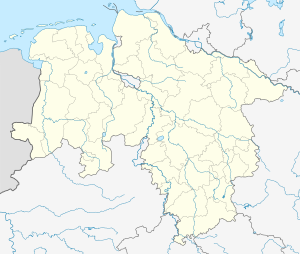Weser tunnel
|
|
||
|---|---|---|
|
Weser Tunnel (aerial view)
|
||
| use | Road tunnel | |
| traffic connection | B437 | |
| length | 1646 m | |
| vehicles per day | 16,000 (2014) | |
| Number of tubes | 2 | |
| cross-section | 2 × 11.3 meters | |
| construction | ||
| building-costs | around 275 million euros | |
| start of building | February 16, 1998 | |
| completion | 2003 | |
| business | ||
| operator | Lower Saxony State Authority for Road Construction and Transport - Regional Business Area Oldenburg | |
| release | January 20, 2004 | |
| location | ||
|
|
||
| Coordinates | ||
| West portal | 53 ° 26 ′ 13 " N , 8 ° 28 ′ 43" E | |
| East portal | 53 ° 26 ′ 15 " N , 8 ° 30 ′ 12" E | |
The Wesertunnel since 2004 as connecting Weser under cross forming part of the B 437 the Lower Saxon counties Wesermarsch and Cuxhaven . It is 1.6 kilometers long and its deepest point is 40 meters below sea level . It is the only fixed crossing of the Weser north of Bremen . This shortens the fixed road connection between the coastal cities of Bremerhaven and Nordenham .
Building history
Several variants of a Weser tunnel were planned as part of a coastal motorway in the 1960s . When this was officially abandoned, the plans were pursued as an independent structure. At the beginning of the 1990s, the then red-green state government expressly stipulated the regional character with consideration for the smaller coalition partner, but it was retained that the dimensions were suitable for long-distance transport. Since the Greens left the state government, it has again been viewed as part of the planned coastal motorway (former A 22 , now A 20 ), which will lead from the Lower Elbe near Stade via the Weser tunnel to the A 28 near Westerstede . However, the plans for this are controversial in parts of the population and among nature conservation associations. The state government is pushing ahead with the planning, while the federal government is reluctant.
The Weser Tunnel was officially opened to traffic on January 20, 2004 after a construction period of six years. The construction costs amounted to around 275 million euros (which - as of 2015 - would correspond to around 341 million euros). The construction of the tunnel was controversial from the start of planning, partly due to the discontinuation of the previous ferry traffic and the loss of jobs.
Ferry connections
The ferry connection Kleinensiel - Dedesdorf was closed with the opening of the tunnel on January 20, 2004 at midnight. The ferry Dedesdorf was sold to Bremen and now operates under the name Vegesack on the Lemwerder - Vegesack ferry line . The Stadland ferry was initially used on the Brake - Sandstedt ferry line , but was later sold to Romania and now operates on the Danube .
The Golzwarden - Sandstedt ferry connection has clearly lost its use, and two ferries (MF Wesermarsch and MF Golzwarden ) at the location there have been sold. Initially, there were considerations to completely stop ferry traffic on the Golzwarden – Sandstedt route in 2005. However, privatization took place in which several captains of the ferry connection founded a company and continued operations with MF Kleinensiel . The Weser ferry from Nordenham to Bremerhaven continues, but with significant losses in transport numbers. The elimination of the ferry connections has changed the situation, especially for non-motorized road users, as the tunnel is closed to pedestrians and cyclists. However, new bus connections have been set up through the tunnel, which allow bicycles to be taken between 9 a.m. and 5:30 p.m.
Traffic importance
The Traffic Club Germany (VCD) summed up the beginning of 2005 that the Wesertunnel has lagged far behind expectations overall. Above all, the labor market balance was sobering. The Weser Tunnel has cost at least 70 jobs so far (not only on the Weser ferries), and neither the Lower Saxony Ministry of Economics nor the Oldenburg Chamber of Commerce and Industry have so far been able to show positive effects on jobs. The prepared industrial areas near the Weser tunnel are still partially empty.
According to the Lower Saxony Ministry of Transport , around 11,500 vehicles per day drove through the tunnel in 2005; the traffic volume forecast for 2010 was around 20,000 vehicles per day. Compared to the traffic volumes that were carried on the three northern Weser ferries up to the end of 2003 (together around 5500 vehicles per day), the expected increase in traffic, which was expected to have a stimulating effect on economic development, has already occurred.
Security tests
In a tunnel test by the ADAC in 2004, the Weser tunnel was rated “very good”. However, the smoke alarms in the Weser Tunnel also react in heavy fog , which has already led to the tunnel being closed several times.
gallery
Web links
- Lower Saxony State Authority for Road Construction and Transport : The Weser Tunnel
- Construction project: Weser tunnel as part of the B 437 near Dedesdorf Bauunternehmen Deutag
- Stolpe and Wulff officially open the Weser Tunnel - a mammoth project between Dedesdorf and Kleinensiel cost 365 million euros - Heiner Stahn and Jan-Philipp Hein asked for the coastal motorway 22 on welt.de on January 21, 2004




